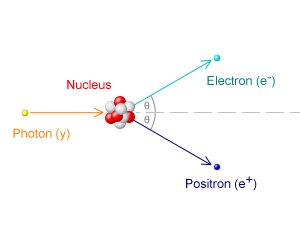Pair production
| Pair production | |
 |
|
| Light-matter interaction | |
| Low energy phenomena | Photoelectric effect |
| Mid-energy phenomena | Compton scattering |
| High energy phenomena | Pair production |
Pair production refers to the creation of an elementary particle and its antiparticle, usually from a photon (or another neutral boson). This is allowed, provided there is enough energy available to create the pair – at least the total rest mass energy of the two particles – and that the situation allows both energy and momentum to be conserved (though not necessarily on shell). All other conserved quantum numbers (angular momentum, electric charge) of the produced particles must sum to zero — thus the created particles shall have opposite values of each (for instance, if one particle has strangeness +1 then another one must have strangeness −1).
Contents |
Examples
Electron-positron pair production
In nuclear physics, this occurs when a high-energy photon interacts in the vicinity of a nucleus, allowing the production of an electron and a positron pair without violating conservation of momentum. Since the momentum of the initial photon must be absorbed by something, pair production cannot occur in empty space out of a single photon; the nucleus (or another photon) is needed to conserve both momentum and energy (consider the time reversal of Electron-positron annihilation).[1]
Energy
Photon-nucleus pair production can only occur if the photons have an energy exceeding twice the rest mass (me) of an electron (1.022 MeV), photon-photon pair production may occur at 511 KeV; the same conservation laws apply for the generation of other higher energy leptons such as the muon and tauon (for two photons each should have the one-particle energy in the center of momentum frame, for one photon and a heavy nucleus, the photon needs the entire pair rest energy). These interactions were first observed in Patrick Blackett's counter-controlled cloud chamber, leading to the 1948 Nobel Prize in Physics.
In semiclassical general relativity, pair production is also invoked to explain the Hawking radiation effect. According to quantum mechanics, at short scales short-lived particle-pairs are constantly appearing and disappearing (see quantum foam); in a region of strong gravitational tidal forces, the two particles in a pair may sometimes be wrenched apart before they have a chance to mutually annihilate. When this happens in the region around a black hole, one particle may escape, with its antiparticle being captured by the hole.
Pair production is also the hypothesized mechanism behind the Pair instability supernova type of stellar explosions, where pair production suddenly lowers pressure inside a supergiant star, leading to a partial implosion, and then explosive thermonuclear burning. Supernova SN 2006gy is hypothesized to have been a pair production type supernova.
In 2008 the Titan laser aimed at a 1-millimeter-thick gold target was used to generate positron electron pairs in large numbers.[2]
See also
- Electron-positron annihilation
- Meitner–Hupfeld effect
- Pair instability supernova
References
- ↑ Hubbell, J. H. (June 2006). "Electron positron pair production by photons: A historical overview". Radiation Physics and Chemistry 75 (6): 614–623. doi:10.1016/j.radphyschem.2005.10.008. Bibcode: 2006RaPC...75..614H.
- ↑ "Laser technique produces bevy of antimatter". MSNBC. 2008. http://www.msnbc.msn.com/id/27998860/. Retrieved 2008-12-04. "The LLNL scientists created the positrons by shooting the lab's high-powered Titan laser onto a one-millimeter-thick piece of gold."